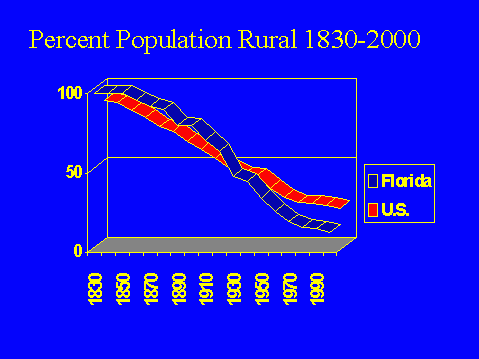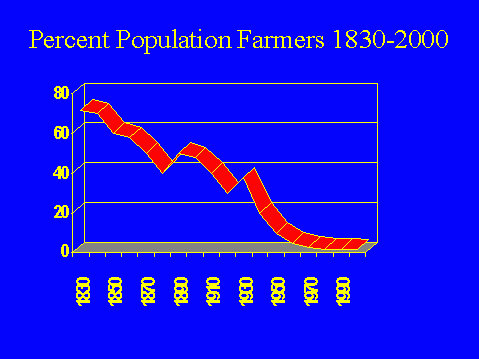Land Grant & Sea Grant:
Events Leading to the Establishment of Land-Grant Universities
What is a Land-Grant Institution?
A land-grant college or university is an institution that has been designated by its state legislature or Congress to receive the benefits of the Morrill Acts of 1862 and 1890. The original mission of these institutions, as set forth in the first Morrill Act, was to teach agriculture, military tactics, and the mechanical arts as well as classical studies so that members of the working classes could obtain a liberal, practical education.
Over the years, land-grant status has implied several types of federal support. The first Morrill Act provided grants in the form of federal lands to each state for the establishment of a public institution to fulfill the act's provisions. At different times money was appropriated through legislation such as the second Morrill Act and the Bankhead-Jones Act, although the funding provisions of these acts are no longer in effect.
A key component of the land-grant system is the agricultural experiment station program created by the Hatch Act of 1887. The Hatch Act authorized direct payment of federal grant funds to each state to establish an agricultural experiment station in connection with the land-grant institution there. The amount of this appropriation varies from year to year and is determined for each state through a formula based on the number of small farmers there. Each state must match a major portion of these federal funds.
Why were the Land-Grants created?
Agricultural-based society of early America
At the time America was becoming established, society and the economy were primarily agricultural-based. Initially, most people lived in rural areas and a significant number of people relied upon agriculture for their livelihood. In the mid-1800s when the Morrill Act took effect, the rural population in the U.S. was over 80% and over 95% for Florida. Since that time, rural numbers have declined to 23% in the U.S. and 13% for Florida. The number of farmers in the U.S. has displayed a similar tract.


In the nineteenth century, agriculture was obviously the primary occupation for people and it was the nation’s main pursuit. Unfortunately, rural areas were lagging far behind towns and cities. There was widespread illiteracy and economic conditions were discouraging. Farming too was very inefficient. For the most part, farm production was at a subsistence level. In 1860, one farm only produced enough food to feed five people, which is in stark contrast to today’s production level of over 140 people per.

The early American colleges and agricultural education
The original colleges in the United States were based upon the English University model that focused on the classics. Many of these colleges were established in the early to mid-1800’s to prepare students specifically in the areas of religion, medicine and law. These universities tended to serve the male leisure classes, government leaders and professionals. Very few schools offered instruction in agriculture and other technical areas that would be applicable for the rural population. Those who wanted to
The development of agricultural societies was the first systematic attempt to improve agriculture. These societies first started after the Revolutionary War and grew to a national level of 900 societies by 1861. The first organized society and one of the most notable was the Philadelphia Society for Promoting Agriculture, established in 1785 by Benjamin Franklin. This society is still in existence today and their regular meetings focus on guest lecturers across various agricultural topics.
The growth of these agricultural societies played an important educational role in their time. They published journals, sponsored educational programs and offered subsidies for premiums to award agricultural innovations. Societies were successful with sharing new agricultural information, but many farmers were slow to adopt the use of improved crops and livestock as they felt little need for change. The societies began to push for colleges where students could study agriculture since they realized that a
The first agricultural schools and notable individuals
Jonathan Turner was an early advocate for agricultural schools. He was a Yale graduate who had been a farmer, newspaper editor, and professor at Illinois College. He presented a "Plan for a State University for the Industrial Classes" in 1850 that contained many of the ideas that became the Morrill Act of 1862. Another advocate, Thomas Clemson, promoted education in science and agriculture, and he was instrumental in establishing colleges along the eastern coast of the U.S.
The first school that was devoted to the study of agriculture was Gardiner Lyceum in Maine established in 1823. Other colleges, such as Kings College (Columbia University) and Harvard College, began to offer instruction in areas of practical agriculture.
Pennsylvania established the first agricultural high school in 1855, which in 1862 became the state’s Land-Grant College and eventually Pennsylvania State University. Evan Pugh was the first president of the Agricultural College of Pennsylvania, and his concept was to not only train farmers and farmers’ wives, but also research specialists and rural school teachers. He envisioned an institution that would be professionally scientific, where agriculture and the mechanic arts could be combined into one college.
Many years of pressure from a Michigan Agricultural Society resulted in Michigan being the first state to establish a college of agriculture in 1855. Shortly thereafter, Maryland established a college of agriculture in 1856. These three states (Pennsylvania, Michigan and Maryland) became the pioneers for the national movement for institutions focusing on agriculture and the mechanical arts.
The Morrill Act of 1862
Within a short time, other states followed Pennsylvania, Michigan and Maryland and legislated schools for the study of agriculture. Unfortunately, many of these schools lacked quality teachers, curriculum and adequate financial resources. Many people felt that these colleges would not receive adequate support without the financial support of the federal government. Because of this public sentiment, Vermont Representative Justin Morrill introduced the first land-grant bill to congress in 1857.
The initial Land-Grant Act was vetoed by President Buchanan who cited the following reasons: current economic conditions, the danger of land speculators, the inclusion of science and liberal studies, and that Congress did not have a constitutional right to appropriate federal money for education.
Three years later, Morrill introduced his bill again with an added provision for teaching military tactics. This time the bill passed Congress, and President Lincoln signed the Morrill Act into law on July 2, 1862.
The first three states to accept the Morrill Act were Iowa, Vermont and Connecticut within 1862. In 1863, fourteen states had adopted the Act. Within eight years of its signing (1870), 37 states had instituted a program for teaching agriculture, mechanical arts and military tactics.
Representative Morrill was not able to attend college himself, but nevertheless he was a strong advocate for education. He was a businessman and an avid horticulturist. He devoted a significant amount of time reading and learning on his own. Much of this investigation was focused on studying access to higher education and education’s positive influence to the common citizen.
There were three main events that gave support to the Land-Grant Act for Representative Justin Morrill and his supporters.
- To increase the efficiency of agricultural production. Farming was the primary source of income for much of the population, and current production was extremely inefficient.
- To provide direly needed education to farmers and the rural population. Colleges at that time had little (if any) interest in educating farmers and the common population in agriculture and the mechanical/practical arts.
- The federal government owned over one billion acres of land in the Western territory, and there was disagreement as to how this would be shared and divided. The Land-Grant Act proposed an ingenious plan to use and share these federal territories among all the states.
Note: through this act, 17.5 million acres were given to states. This land was then sold by states and the sales income was to be used to support teachers within the states’ Land-Grant College.
Morrill’s bill was designed to donate federal land (30,000 acres) to each state and territory as an endowment. The intent of the bill was to provide a broad segment of the population with a practical education that had direct relevance to their daily lives. The bill’s purpose was to establish:
"at least one college in each state where the leading object shall be, without excluding other scientific or classical studies, to teach such branches of learning as are related to agriculture and the mechanic arts, as the legislatures of the states may respectively prescribe, in order to promote the liberal and practical education of the industrial classes in the several pursuits and professional of life."
The Morrill Act of 1890
Senator Morrill introduced twelve bills to Congress between the years 1872 and 1890 in an attempt to obtain more help for states with the new land-grant colleges. In 1890, he introduced a bill that passed. This bill specified that states that maintained separate colleges for the different races had to propose a just and equitable division of the funds to be received under the act. Any states that had used their 1862 funds entirely for the education of white students were forced to either open their facil
This act served to establish sixteen black land-grant colleges throughout the South. Furthermore, it provided for teaching some of the arts and all of the sciences, and it paved the way for the development of university systems beyond colleges focusing primarily on agriculture and the mechanical arts.
The National Agricultural Research, Extension and Teaching Act of 1994
This federal act conferred land-grant status on 29 Native American colleges as a provision of the Elementary and Secondary Education Reauthorization Act. The bill authorized a $23 million endowment for these colleges, and this was to be built up over five years. Each college receives annual interest payments from this endowment fund to support land-grant initiatives for Native Americans.
Today’s Land-Grant Universities
Since their inception, land-grant institutions have broadened out to encompass programs of on-campus instruction, research, and off-campus Extension work in many areas beyond the initial educational needs of the agricultural and industrial classes. Several acts have been passed since 1862 that have expanded the scope and increased the support of land-grant programs. In all, there are 105 Land-Grant Colleges and Universities stemming from the 1862, 1890 and 1994 federal legislation.
The current federal appropriation to states for their land-grant systems amounts to more than $550 million dollars per year. These funds are allocated to states based upon several factors. Some funds go in equal amounts to all states; some go to the states on the basis of their farm population, or on their total population in relation to the total population of the United States. The United States Department of Agriculture (USDA) administers land-grant funds and the coordination of land-grant activities.
Even though land-grant universities have greatly expanded and grown since 1862, they have a mandate to openness, accessibility, and service to people. Many of these institutions are among the ranks of the most distinguished public research institutions, and all share the same tripartite mission of Teaching, Research and Extension. Through this innovative system, millions of students and citizens have been able to receive educational benefit from an institution of higher learning across all academic disciplines.
Sources of Information
NASULGC. 1995. The Land-Grant Tradition. Office of Public Affairs, NASULGC. Washington, DC.
Place, Nick T. 1999. Lecture notes from AEE 3313 -- Role and Development of Extension Education.
Seevers, Brenda, Donna Graham, Julia Gamon, Nikki Conklin. 1997. Education through Cooperative Extension. Delmar Pub. Albany, NY.
Materials for this module were developed by Nick T. Place, Assistant Professor, Department of Agricultural Education and Communication, IFAS / University of Florida.
